1. Introduction
The futility of man’s ‘I’-ness, that is, of ego can be realised from Saint Dnyaneshwar’s quote – ‘He who says I have attained it, knows nothing’.
Ego is a major obstacle in the path of man’s worldly and spiritual happiness. Since the seed of ego is present at the very birth of man, ego is invariably present in everyone, be it young or old, rich or poor, educated or uneducated, etc. to a lesser or greater extent. Ego is akin to the weeds in a field. Until the weeds are uprooted completely, we cannot cultivate a good crop. The weeds have to be uprooted regularly. Similarly, it is not possible to obtain God’s grace without complete destruction of one’s ego. Ego is so deeply ingrained in man that though the very objective of sadhana (Spiritual practice) is destruction of ego, it is not easy to eliminate it quickly even after performing spiritual practice. Hence, instead of thinking that ego will be dissolved automatically by performing spiritual practice, we should make conscious efforts towards destroying ego.
2. Ego definition and meaning
2A. Ego definition is considering oneself to be distinct from others and Brahman or God, due to the physical body or due to the sankars (Subconscious impressions) in various centres of the lingadeha (Subtle-body).
2B. In general, ego definition is stated as a pride related to ‘me’, ‘mine’ ‘for myself’. Thoughts such as ‘my body and mind’, ‘my intellect’, ‘my life’, ‘my wealth’, ‘my wife and children’, ‘I should obtain happiness’, etc. arise from ego alone. ‘When we peel an onion, all that we get are only the peels and nothing at the core. Similarly, we will not find an object called ‘I’. Eventually, what remains is the Atma – Chaitanya.’
3. Types of ego
3 A. God’s ego
The word ‘ahankar’ is derived from the words ‘aham (Ego)’ and ‘akar (Form)’. When the form dissolves, only ego remains. At that time, ‘I’-ness manifests without dvait (Duality), that is, only Brahman, God exists. ‘I’-ness that is devoid of ego itself is Brahman or God.
3 B. Man’s ego
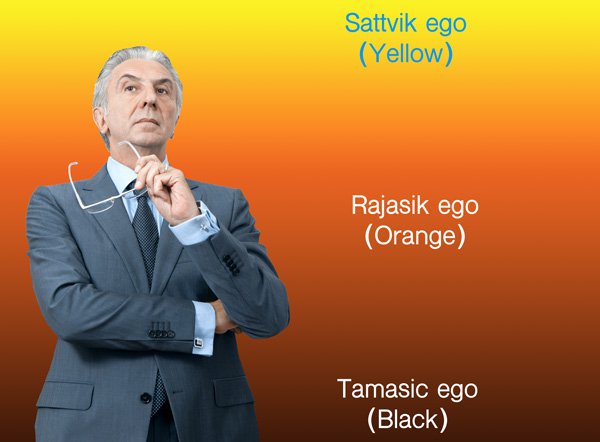
Pure ego
This can be explained as follows.
-
Considering oneself to be distinct from Brahman, that is, having awareness of the self through dvait.
-
Having an awareness only of the existence.
-
Having a bhav (spiritual emotion) that ‘I belong to others and others are mine’. Pure ego remains till the existence of the physical body.
Impure ego
When the mind, chitta, intellect and ego are created, and when their creation attains a peak, we can assume that the antahakarana (The inner sense organs consisting of the conscious mind, subconscious mind, intellect and ego) has fully developed. All activities for obtaining worldly happiness take place with the help of ego. With regard to intellect and ego in the Kaliyug (Era of strife), we can say that complete development of intellect implies considering yourself as the body (Having body-awareness). For obtaining physical pleasures, the height of wisdom used is intellect. Ego refers to complete development of the intellect.
Awareness of the existence due to the physical body or due to sankars in the centres of the lingadeha like temperamental characteristics, desires, likes and dislikes, etc. is termed as impure ego. Depending on the thoughts and emotions, this ego can be either sattvik (Sattva-predominant), rajasik (Raja-predominant) or tamasic (Tama-predominant). These three types of ego are known as aham-traya or trividhaaham.
-
Tamasic ego : Ego which is Tama- predominant is called bhutadi or tamasic ego; for example, taking self-credit.
-
Rajasik ego : Raja-predominant ego is called taijas or rajasik ego; for example, constantly striving for happiness.
-
Sattvik ego : Ego which is predominant in the Sattva component is called vaikrut or sattvik ego; for example, ego related to sacrifice is sattvik in nature.
3 C. Types according to the proportion of ego
The amount of ego in an average individual is 30%. Depending on the proportion of ego, it can be classified into the following three types.
| Proportion of ego % | Types of ego |
|---|---|
| 20 – 30 | High |
| 15 – 20 | Moderate |
| 10 – 15 | Low |
3 D. Panchatattva (The five Cosmic Principles) and types of ego
Pruthvi (Absolute Earth Principle), Apa (Absolute Water Principle), Tej (Absolute Fire Principle), Vayu (Absolute Air Principle) and Akash (Absolute Ether Principle) are the five Cosmic Principles. The following table lists out the combined Principles and the type of ego associated with them.
| Combined principles | Type of ego |
|---|---|
| Tej + Pruthvi | Tamasic |
| Tej + Apa | Rajasik |
| Tej + Vayu | Sattvik |
3 E. Colour and type of ego
Leaving aside Supreme God, everything is made of trigunas (The three basic components of the human body – Sattva, Raja and Tama). Blue and yellow colours are sattvik in nature. Hence, we feel pleasant while looking at them. Orange colour is rajasik in nature, hence, we experience Shakti (Divine Energy) while looking at it. Black colour is tamasic in nature, hence, we do not feel like looking at it. Therefore, black colour has been generally considered inauspicious in Hindu Dharma; for example, during an auspicious event one does not wear or use black clothes.
As per the trigunas, ego is also of three types – tamasic, rajasik and sattvik ego. Tamasic Ego is denoted by black, rajasik ego is denoted by orange and sattvik ego is denoted by yellow. Tamasic ego is intense, rajasik ego is moderately intense and sattvik ego is extremely less; therefore, an individual with high ego emits vibrations of Tama component and one does not feel like looking at or speaking with that individual.
3F. Types of ego according to the
spiritual level, spiritual practice and life
| Spiritual level (%) | Spiritual practice | Ego (%) | Predominant component | Mainly, ego is because of life / Ego |
|---|---|---|---|---|
| Ego | ||||
| 10 | No spiritual practice | Above 35 – 40 | Tama | Anti-Dharmik, power, respect, authority, jealousy, etc. |
| 20 | No spiritual practice | 35 – 40 | Tama – raja | Anti-Dharmik, power, respect, authority, etc. |
| 20 | No spiritual practice | 30 | Tama – raja | Business, wealth, intellect, corruption |
| 30 | Puja ( Ritualistic worship ), reading scriptures, pilgrimage | 25 | Raja – tama | Spiritual practice |
| 40 | Study of Holy texts, chanting God’s Name, meditation | 20 | Raja – sattva | Spiritual practice |
| 50 | Satsang, satseva, donating | 15 | Sattva – raja | Tyag (Sacrifice), spiritual experience, sect, Guru |
| Life | ||||
| 60 | Tyag, Priti | 10 | Sattva | Yearning for God realisation |
| 79 – 99 | Shivadasha (The state of being one with Shiv [God Principle]) | 5 | Pure sattvik | Upliftment of the jivas |
| 100 | No spiritual practice is performed due to advait (Non-duality) | 0 | Trigunatit (The state beyond trigunas [Three spiritual components]) | Entirely for God’s wish |
Reference : Sanatan Sanstha’s Holy text ‘Spiritual Practice for Destroying Ego’.

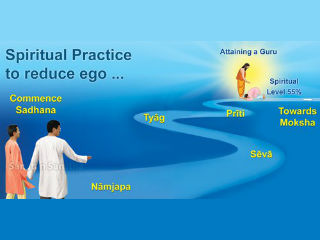 Important components of spiritual practice to reduce ego
Important components of spiritual practice to reduce ego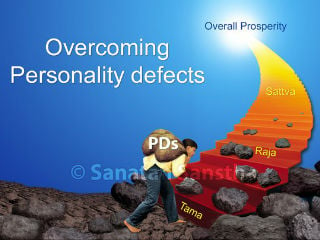 How to reduce Ego problem According to Psychology
How to reduce Ego problem According to Psychology How to reduce Ego according to Bhaktiyoga (Path of Devotion)
How to reduce Ego according to Bhaktiyoga (Path of Devotion) Harm incurred due to high ego and why it is important to destroy ego ?
Harm incurred due to high ego and why it is important to destroy ego ?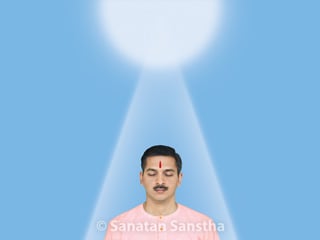 Signs of Spiritual growth after reduction in Ego
Signs of Spiritual growth after reduction in Ego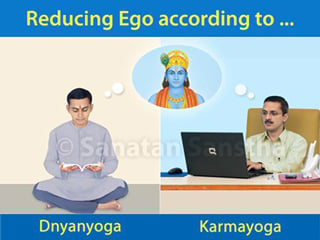 Methods of Ego reduction according to Karmayoga (Path of Action) and Dnyanyoga (Path of Knowledge)
Methods of Ego reduction according to Karmayoga (Path of Action) and Dnyanyoga (Path of Knowledge)